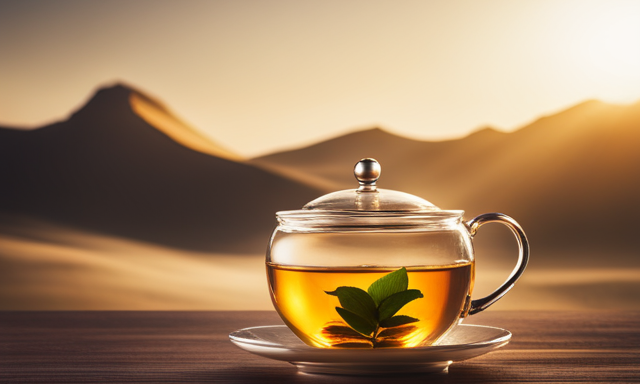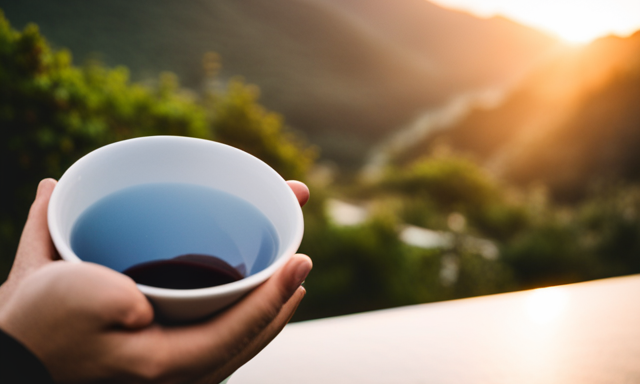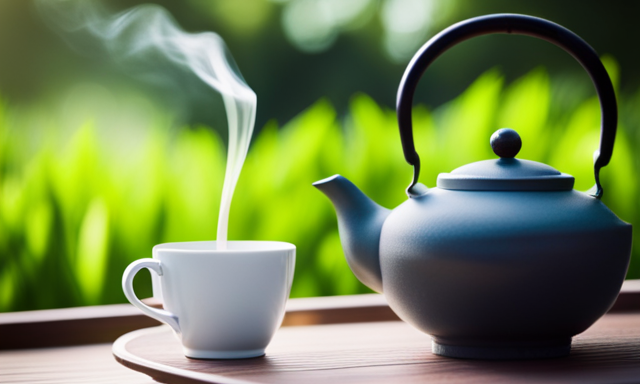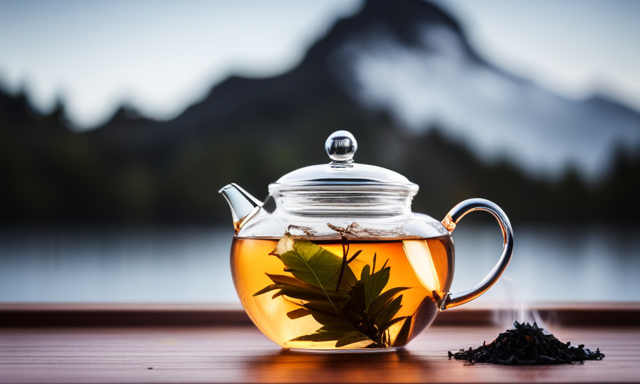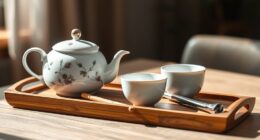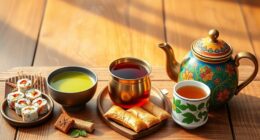Have you ever found yourself standing in the tea aisle, staring at the shelves filled with different types of oolong tea, wondering how long you should steep them for the perfect cup? Well, you’re not alone. I used to be in the same predicament until I decided to delve into the world of oolong tea and unlock its secrets.
In my quest for the ideal oolong tea experience, I discovered that the steeping time is crucial in extracting the nuanced flavors and aromas that make this tea so special. From floral and fruity to toasty and earthy, each oolong tea requires a specific steeping time to reach its full potential.
Through countless trials and taste tests, I have gathered valuable insights on the factors that affect steeping time, the recommended times for different oolong teas, and the proper brewing techniques to ensure a delightful cup every time.
Join me on this journey as we explore the art of steeping oolong tea and elevate our tea-drinking experience to new heights.
Key Takeaways
- Steeping times for oolong tea can vary depending on the desired flavor intensity, with shorter steeping times resulting in a lighter, delicate flavor and longer steeping times resulting in a stronger, robust flavor.
- Avoid steeping oolong tea for too long, as it can lead to a bitter taste, and avoid steeping for too short a time, as it can result in a weak flavor.
- Different types of oolong tea have recommended steeping durations, such as 2-3 minutes for green oolong, 3-4 minutes for traditional oolong, and 4-5 minutes for dark oolong.
- Proper storage in an airtight container away from light, moisture, and strong odors can help preserve the freshness of oolong tea for up to two years.
Understanding Oolong Tea: A Brief Overview
Oolong tea is a unique type of tea that is partially oxidized, giving it a distinct flavor profile. The oxidation levels of oolong tea can range from 10% to 80%, resulting in a wide range of flavors and aromas.
The brewing technique for oolong tea is crucial in bringing out its unique characteristics. Generally, oolong tea is steeped using water that is around 180°F to 200°F for 2 to 5 minutes. However, the steeping time can vary depending on the specific oolong tea variety and personal preference.
Some oolong teas benefit from shorter steeping times, around 1 to 2 minutes, while others may require longer steeping times of up to 7 minutes. It is important to experiment and adjust the steeping time to achieve the desired flavor and strength.
Factors such as tea leaf quality, water temperature, and personal taste also play a significant role in determining the steeping time for oolong tea. With that in mind, let’s now explore the factors that can affect the steeping time of oolong tea.
Factors Affecting Steeping Time
When it comes to steeping oolong tea, there are a few key factors that can affect the recommended steeping time.
One of these factors is the variety and oxidation level of the tea. Different tea varieties and levels of oxidation can result in variations in flavor and aroma, which can also impact the steeping time.
Additionally, the water temperature used for steeping is another crucial factor. Higher temperatures can extract more flavor from the tea leaves, while lower temperatures can result in a milder infusion.
Tea Varieties and Oxidation Levels
To fully appreciate the rich flavors of oolong tea, let your senses be whisked away by the varying levels of oxidation found in different tea varieties.
The tea oxidation process plays a crucial role in determining the flavor profile and health benefits of oolong tea. Here are four key factors to consider:
-
Lightly oxidized oolong: This type of tea is floral and delicate, with a greenish hue and subtle sweetness.
-
Moderately oxidized oolong: With a more pronounced flavor, these teas exhibit fruity and nutty notes, along with a smooth mouthfeel.
-
Darkly oxidized oolong: These teas are robust and bold, often showcasing caramel and roasted flavors.
-
Highly oxidized oolong: Known as ‘black dragon’ tea, this variety is rich and earthy, with a deep amber color and a complex taste.
Understanding these different tea varieties and their oxidation levels allows you to choose the perfect oolong tea to suit your taste preferences.
Now, let’s dive into the next section and explore the impact of water temperature on oolong tea brewing.
Water Temperature
Water temperature is like the conductor of an orchestra, influencing the harmonious extraction of flavors from the oolong tea leaves. Proper temperature control during steeping is essential to achieve the best taste.
Oolong tea is known for its delicate and nuanced flavors, which can be easily affected by water temperature. Generally, oolong tea is steeped at temperatures ranging from 185°F to 205°F (85°C to 96°C).
Steeping the tea at lower temperatures, around 185°F (85°C), allows for a lighter and more floral flavor profile. On the other hand, higher temperatures, around 205°F (96°C), bring out a richer and more robust taste.
The steeping duration for oolong tea can vary depending on personal preference or the specific oolong tea variety. In the next section, we will explore the recommended steeping times for different oolong teas, ensuring a perfect brew every time.
Recommended Steeping Times for Different Oolong Teas
For the best flavor and aroma, it’s recommended to let different oolong teas steep for varying amounts of time. Here are some recommended steeping times for different oolong teas:
-
Lightly oxidized oolongs, such as green oolongs, should be steeped for 1-2 minutes. This preserves their delicate flavors and floral notes.
-
Moderately oxidized oolongs, like pouchong and jade oolongs, should be steeped for 2-3 minutes. This allows their fruity and creamy flavors to develop fully.
-
Highly oxidized oolongs, such as Oriental Beauty and Da Hong Pao, require a longer steeping time of 3-5 minutes. This brings out their rich, roasted flavors.
-
Aged oolongs, like Tie Guan Yin and Shui Xian, benefit from a longer steeping time of 5-7 minutes. This allows their complex flavors to unfold.
Experimenting with steeping time can help you find the perfect balance for your taste preferences. So go ahead and explore the world of oolong teas, adjusting the steeping time to unlock their full potential.
Experimenting with Steeping Time
When it comes to steeping oolong tea, finding your personal preference is key. Experimenting with different steeping times allows you to discover the flavor intensity that suits your taste buds.
By adjusting the steeping time, you can control the strength of the tea, whether you prefer a lighter or stronger brew.
So go ahead and explore the world of oolong tea by tweaking the steeping time to find your perfect cup.
Finding Your Personal Preference
To truly discover your personal preference, steep oolong tea for varying lengths of time and let the contrasting flavors dance on your taste buds. Experimenting with steeping time allows you to unlock the full potential of this exquisite tea. As you explore different steeping durations, you will notice a range of flavors and aromas that emerge. To help you visualize the possibilities, here is a table showcasing the flavors you can expect based on steeping time:
| Steeping Time | Flavor Profile |
|---|---|
| 1-2 minutes | Light and floral |
| 3-4 minutes | Balanced and aromatic |
| 5-6 minutes | Rich and toasty |
| 7-8 minutes | Bold and robust |
| 9+ minutes | Full-bodied and intense |
By adjusting the steeping time, you can achieve the desired flavor intensity. So, let’s delve into the next section and explore how to fine-tune the steeping time for a truly personalized oolong tea experience.
Adjusting Steeping Time for Flavor Intensity
Immerse yourself in the art of oolong tea by adjusting the steeping time to maximize the flavor profile of this exquisite beverage.
Oolong tea offers a wide range of flavors, from light and floral to deep and robust. By adjusting the steeping time, you can control the intensity of these flavors and create a truly personalized cup of tea.
For a lighter and more delicate taste, steep the leaves for around 2-3 minutes. If you prefer a stronger and more full-bodied flavor, extend the steeping time to 4-5 minutes.
Experiment with different steeping times to find your perfect balance of flavors. Once you have mastered adjusting the steeping time, you can move on to exploring proper oolong tea brewing techniques, ensuring a consistently delightful cup every time.
Proper Oolong Tea Brewing Techniques
Steeping oolong tea for the perfect amount of time can make all the difference, as it brings out the tea’s unique flavors and aromas, leaving you craving for more.
When it comes to proper oolong tea brewing techniques, there are a few key steps to follow:
-
Start by finding the best oolong tea brands. Look for reputable companies that source their tea from high-quality leaves to ensure a flavorful brew.
-
Understand the benefits of oolong tea for health and wellness. Oolong tea is known for its potential to aid in weight loss, boost metabolism, and promote heart health, among other benefits.
-
Experiment with different steeping times. Oolong tea can be steeped for anywhere between 3 to 7 minutes, depending on personal preference. Adjusting the steeping time can enhance or mellow the flavors.
By mastering these proper brewing techniques, you can unlock the full potential of oolong tea.
Now, let’s dive into some tips for enhancing oolong tea flavors.
Tips for Enhancing Oolong Tea Flavors
To enhance the flavors of your oolong tea, try experimenting with different steeping times. Allow the tea to unfurl like a delicate flower and release its intricate flavors into your cup.
The duration of steeping plays a crucial role in determining the aroma and taste of your oolong tea. For a lighter and more delicate flavor, steep the tea for around 2-3 minutes. This will result in a smooth and floral infusion with a subtle aroma.
If you prefer a stronger and more robust flavor, steep the tea for 4-5 minutes. This will bring out the tea’s rich and complex flavors, offering a deeper and more satisfying experience.
Additionally, consider pairing your oolong tea with complementary foods, such as light pastries or fruits, to enhance the overall sensory experience.
Now, let’s explore some common mistakes to avoid when brewing oolong tea.
Common Mistakes to Avoid
When it comes to enhancing the flavors of oolong tea, there are a few common mistakes that should be avoided. One of the most important factors to consider is the steeping duration. Many people make the mistake of steeping oolong tea for too long, resulting in a bitter and overpowering taste. On the other hand, steeping for too short a time can result in a weak and flavorless cup of tea. Finding the perfect balance is crucial to unlocking the full potential of oolong tea. To help you achieve this, I have created a table outlining the recommended steeping durations for different types of oolong tea:
| Type of Oolong Tea | Steeping Duration |
|---|---|
| Green Oolong | 2-3 minutes |
| Traditional Oolong | 3-4 minutes |
| Dark Oolong | 4-5 minutes |
By following these guidelines, you can avoid the common mistake of over or under steeping your oolong tea. Now, let’s move on to the next section and learn about storing oolong tea for freshness.
Storing Oolong Tea for Freshness
When it comes to storing oolong tea for freshness, there are a few key points to keep in mind.
First, it’s important to store the tea in a proper container and environment to prevent it from losing its flavor and aroma.
Second, understanding the shelf life of oolong tea is crucial to ensure you enjoy it at its best.
Lastly, aging effects can greatly impact the taste and quality of oolong tea, so being aware of these effects is essential for tea enthusiasts.
Proper Container and Environment
Steeping oolong tea in a ceramic teapot can enhance its flavor and aroma, creating a more enjoyable tea-drinking experience. Using a ceramic teapot is ideal because it helps retain heat and ensures a consistent temperature throughout the steeping process. The porous nature of ceramic also allows for the tea leaves to breathe, releasing their natural flavors. Additionally, a ceramic teapot is easy to clean and maintain, preventing any residual flavors from transferring to future brews.
Creating the right steeping environment is equally important. It is recommended to steep oolong tea in water that is around 185°F (85°C) and allow it to steep for about 3-5 minutes. This allows the tea to fully infuse, resulting in a balanced and flavorful cup.
Now, let’s explore the effects of shelf life and aging on oolong tea.
Shelf Life and Aging Effects
To fully appreciate the rich and complex flavors of oolong tea, it’s important to understand the effects of shelf life and aging. Aging effects play a crucial role in the taste and quality of oolong tea. Here are three key points to consider:
-
Flavor enhancement: Oolong tea undergoes a natural aging process that allows the leaves to develop more depth and complexity in flavor. With time, the tea gains a smoother and more mellow taste, making it a delight to savor.
-
Maximizing freshness: Properly stored oolong tea can retain its freshness for up to two years. It’s important to keep it in an airtight container away from light, moisture, and strong odors. This preserves the tea’s delicate aromas and prevents it from becoming stale.
-
Aging potential: Some oolong teas, like high-quality aged oolongs, can improve in taste and value over time. Just like fine wine, these teas age gracefully, offering a unique experience to tea enthusiasts.
Understanding the aging effects and maximizing freshness is key to enjoying the full range of flavors that oolong tea has to offer.
Now, let’s delve into the exciting world of exploring different oolong tea origins and flavors.
Exploring Different Oolong Tea Origins and Flavors
Discover the diverse origins and flavors of oolong tea, and let your taste buds embark on a flavor journey like no other. Oolong tea is cultivated in various regions, each offering unique characteristics and taste profiles. From the mountainous regions of Taiwan to the Fujian province in China, the cultivation of oolong tea is a true art form. Tea farmers meticulously tend to the plants, ensuring optimal growth and flavor. The processing techniques also play a crucial role in the final product. With variations in oxidation levels and roasting methods, oolong teas can range from light and floral to dark and toasty. To help you navigate the world of oolong tea, here is a table showcasing some popular origins and their flavor profiles:
| Origin | Flavor Profile |
|---|---|
| Taiwan | Floral, fruity, and creamy |
| Fujian, China | Toasty, earthy, and nutty |
| Guangdong, China | Sweet, floral, and honey-like |
| Darjeeling, India | Muscatel, fruity, and crisp |
Understanding the diverse origins and flavors of oolong tea sets the stage for the art of savoring this exquisite beverage. Transitioning into the next section, let’s explore the art of savoring oolong tea and how to fully appreciate its nuances.
The Art of Savoring Oolong Tea
After exploring the different origins and flavors of Oolong tea, I’m excited to delve into the art of savoring this exquisite beverage. As a tea enthusiast, I have discovered that savoring Oolong tea is a truly enjoyable experience that requires attention to detail. To fully appreciate its complex flavors and aromas, one must employ certain techniques.
-
Observe the tea leaves: Take a moment to appreciate the appearance and color of the leaves before brewing.
-
Engage your senses: Inhale deeply and savor the aroma before taking your first sip.
-
Sip slowly: Allow the flavors to linger on your palate, noticing the subtle changes with each sip.
-
Pair with food: Oolong tea’s versatility makes it a perfect companion to a wide array of dishes, enhancing the flavors and providing a unique sensory experience.
In addition to its delightful taste, Oolong tea offers numerous health benefits, including boosting metabolism, aiding digestion, and promoting relaxation. By savoring this remarkable tea, we can fully indulge in its rich flavors while reaping the rewards of its wellness properties.
Frequently Asked Questions
How long should I steep oolong tea if I want a stronger flavor?
If you want a stronger flavor in your oolong tea, steep it for a longer period of time. The longer the steeping time, the more intense the flavor will become, allowing the tea to release its full aroma and taste.
Can I reuse oolong tea leaves for multiple infusions?
Sure! Reusing oolong tea leaves for multiple infusions is like unlocking a treasure chest of flavors. Each steeping brings out different nuances and complexities, enhancing the overall tea experience. It’s a delightful ritual that maximizes the benefits of oolong tea.
Is it necessary to preheat the teapot or teacups before brewing oolong tea?
Preheating the teapot before brewing oolong tea is not necessary, but it can enhance the flavor and aroma. It helps maintain the optimal temperature, allowing the tea leaves to steep more effectively and release their full potential.
Can I add milk or sweeteners to oolong tea?
Sure, you can add milk or sweeteners to oolong tea, but I recommend savoring its natural flavors. Oolong tea is known for its weight loss benefits, making it a great choice for a healthy and flavorful beverage.
What is the ideal water temperature for steeping oolong tea?
For the ideal steeping time of oolong tea, it’s important to consider the water temperature. The best brewing method involves using water at around 190-200°F to bring out the flavors and aromas of the tea leaves.
Conclusion
In conclusion, steeping oolong tea is a delicate process that requires attention to detail and experimentation. By understanding the factors that affect steeping time and following recommended guidelines, you can ensure a perfect cup of oolong tea every time.
So, how long should you steep oolong tea? Well, that depends on the specific type of oolong and your personal preference.
Remember, the journey of discovering the perfect steeping time is part of the joy of savoring oolong tea. So why not embark on this flavorful adventure and unlock the full potential of this exquisite tea?

